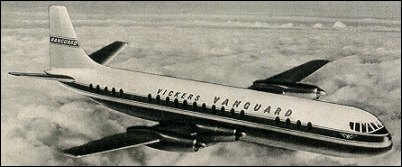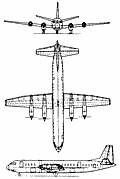 |
Vickers Vanguard1959 |  |
| PASSENGER | Virtual Aircraft Museum / United Kingdom / Vickers |
 |
The very considerable success of the Vickers Viscount in airline service was due to the smoothness, economy and reliability of its turbine engines. In one enormous leap it had raised cruising speed almost 100% by comparison with the piston-engined Vickers Viking; it carried two or three times as many passengers (according to type) and offered increased range. In early 1953, not long after the Viscount entered service with British European Airways (BEA), discussions began to initiate the design of a successor. Both BEA and Trans-Canada Airlines were interested in a generally similar aircraft; compromise in design to satisfy the views of these two operators resulted in the low-wing configuration and 'double-bubble' fuselage to provide a large underfloor cargo hold beneath the main cabin. The power plant considered originally for inclusion in the design was the Rolls-Royce Dart. But Rolls-Royce intimated that development of a new engine, the RB.109, was then well under way and it (later known as the Tyne) was chosen to power this new transport. Construction was entirely conventional except for the wing, which introduced integrally machined skins of light alloy to provide spanwise stiffening at low cost, and three shear webs instead of the single spar in the Viscount wing. When tied together by closely spaced ribs it produced a rigid box structure and outboard of the centre-section it was sealed to form integral fuel tanks. First flight of the prototype Vanguard, as the new aircraft had been named, was made on 20 January 1959. But because of the normal development programme of a new civil airliner - coupled with delays caused by problems with the new power plant - it was not until 1 February 1961 and 1 March 1961 that these aircraft began regular service with Trans-Canada Airlines and BEA respectively. By then this and other second-generation turboprop-powered airliners had been deposed by the development and introduction into service of economical turbojet-powered airliners such as the Boeing Model 707. Consequently production ended after the original orders had been completed: 20 for BEA and 23 for Trans-Canada Airlines. On 10 October 1969 the first of nine freighter conversions of the Vanguard, called Merchantman, was flown for BEA.
|  COMPANY PROFILE | ||||||||||||||||||||||||||||||||||||||||||||||||||||||||||||
 |

|

